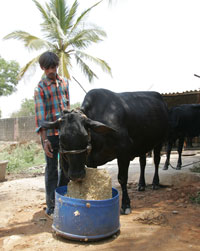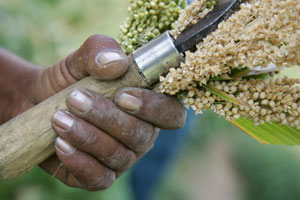Poor livestock keepers in the drylands point to feed shortages as one of their biggest animal production constraints. Research in India is demonstrating that sweet sorghum's traditional use as a dual-purpose food and feed crop and its modern day use as a bio-fuel need not be mutually exclusive
Sweet sorghum (Sorghum bicolor (L.) Moench) is well adapted to the semi-arid regions of the tropics. One of its main advantages is that it is very water-use efficient It has long been used by farmers as a multi-purpose crop from which they extract grain for human consumption and stover for livestock feed. Today, sweet sorghum is becoming increasingly used in industrial bio-fuel production in India. It is one of the most efficient dryland crops to convert atmospheric CO2 into sugar and is therefore a viable alternative for the production of ethanol.
|
Sweet sorghum’s role in India’s bio-fuel plans Excerpted from: ‘Development of Value Chain for Bio-fuel in India’, National Agricultural Innovation Project (NAIP). NAIP website: http://www.naip.icar.org.in |
Win-win situation
Increasing industrial usage of sweet sorghum for ethanol production does, on one hand, provide important income for dryland farmers, but it can also divert biomass away from livestock, thus adding to the feed scarcity problem being faced by livestock keepers. However, scientists are demonstrating that full use of all parts of the sweet sorghum plant can meet both industrial and livestock feed needs.
Collaborative work between the International Crop Research Center for the Semi-Arid Tropics (ICRISAT), the Rusni Distillery in Sanga Reddy Medak District, the Indian Council of Agricultural Research’s National Research Center for Sorghum (NRCS), in Hyderabad, and the International Livestock Research Institute (ILRI) is demonstrating the feasibility of manufacturing marketable sweet sorghum feed blocks using the stripped leaves and the crushed stalks (bagasse) remaining after juice extraction for ethanol. A bagasse-based feed block has been manufactured in collaboration with Miracle Fodder and Feeds in Hyderabad and is currently being tested with large and small ruminants with very promising results.
Full utilization of crops and their by-products in the balanced production of food, feed and industrial products is likely to become increasingly important in developing countries. Total utilization of all parts of the sweet sorghum plant for use in the manufacturing and food industries would help compensate for fodder loss and provide an additional source of income for farmers.
Value-added products from by-products
Surveys of fodder markets in Hyderabad showed that stover from ordinary grain sorghum is widely traded as livestock fodder. This stover is sourced from several Indian States, transported over distances of more than 350 km and fetches retail prices that are about half the value of the sorghum grain. Higher quality stover fetches premium prices ranging from 3.1 to 3.9 Indian rupees per kilogram of dry stover.
The fodder quality of feed blocks made from sweet sorghum leaf strippings and bagasse is similar to premium stover made from grain sorghum. Scientists estimate that this feed could fetch prices of 6 rupees per kg and more. The manufacturing of feed blocks could therefore offer attractive additional income along a sweet sorghum utilization chain. The feed blocks could be made more nutritious by adding sorghum grain distillery by-products—where the grain is used for biofuel production—and/or by targeted fortification with other supplements. The end product would be an attractive sweet sorghum by-product based feed block of good quality and with a high density, making

